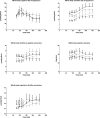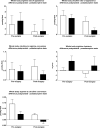Major surgery diminishes systemic arginine availability and suppresses nitric oxide response to feeding in patients with early stage breast cancer
- PMID: 28826699
- PMCID: PMC5799041
- DOI: 10.1016/j.clnu.2017.07.019
Major surgery diminishes systemic arginine availability and suppresses nitric oxide response to feeding in patients with early stage breast cancer
Abstract
Background & aims: Plasma arginine (ARG) levels are reduced in breast cancer, suggesting diminished systemic ARG availability. ARG and its product nitric oxide (NO) are important in early postoperative recovery due to its roles in immune function and wound healing. It remains unclear whether major surgery further diminishes systemic ARG availability due to enhanced ARG catabolism and/or insufficient endogenous ARG synthesis negatively affecting NO synthesis in patients with early stage breast cancer.
Methods: In 9 women with early stage breast malignancy and 9 healthy women with genetic predisposition to breast cancer, whole body ARG and citrulline (CIT) rates of appearances were measured to determine their production rates prior to and within 24 h after major breast surgery by stable isotope methodology in the postabsorptive and postprandial state. The conversions of CIT > ARG, ARG > CIT, and ARG > Urea (markers of de novo ARG and NO synthesis, arginase activity, respectively), and ARG clearance (reflecting ARG disposal capacity) were calculated.
Results: Prior to surgery, plasma ARG, CIT and glutamine concentrations were lower in cancer (P < 0.05) but no differences were found in the rate of appearances of ARG, CIT and their conversions. Surgery increased ARG clearance and reduced CIT rate of appearance, conversion of CIT > ARG (P < 0.001), and plasma ARG, CIT, ornithine concentrations (P < 0.001). Furthermore, postprandial increase in ARG > CIT conversion (P < 0.05), plasma ARG (P < 0.001) and CIT (P = 0.06) concentrations were lower after surgery. The cancer group had lower values for postprandial increase in ARG > CIT conversion, plasma CIT (P < 0.05) and glutamine concentrations (P = 0.08).
Conclusions: Major surgery in early stage breast cancer further reduces systemic ARG availability in the early phase of recovery due to a combined process of increased ARG catabolism and impaired endogenous ARG synthesis. The suppressed postprandial NO increase in early stage cancer suggests that specific nutritional approaches are advised to increase ARG availability after major surgery although the effects on postoperative recovery remain unclear. This trial was registered at clinicaltrials.gov as NCT00497380.
Keywords: Arginine kinetics; Breast surgery; Early stage breast cancer; Nitric oxide synthesis; Stable isotopes.
Copyright © 2017 Elsevier Ltd and European Society for Clinical Nutrition and Metabolism. All rights reserved.
Conflict of interest statement
Conflict of interest
The authors declare no conflicts of interest.
Figures




References
-
- Vissers YL, Dejong CH, Luiking YC, Fearon KC, von Meyenfeldt MF, Deutz NE. Plasma arginine concentrations are reduced in cancer patients: evidence for arginine deficiency? Am J Clin Nutr. 2005;81(5):1142–6. - PubMed
-
- Naini AB, Dickerson JW, Brown MM. Preoperative and postoperative levels of plasma protein and amino acid in esophageal and lung cancer patients. Cancer. 1988;62(2):355–60. - PubMed
-
- Morris SM., Jr Arginine: beyond protein. Am J Clin Nutr. 2006;83(2):508S–12S. - PubMed
-
- Ohki S, Shibata M, Gonda K, Machida T, Shimura T, Nakamura I, et al. Circulating myeloid-derived suppressor cells are increased and correlate to immune suppression, inflammation and hypoproteinemia in patients with cancer. Oncology reports. 2012;28(2):453–8. - PubMed
-
- Gonda K, Shibata M, Ohtake T, Yasuda M, Abe N, Watanabe K, et al. Myeloid-derived suppressor cells in patients with breast cancer. Gan To Kagaku Ryoho. 2012;39(9):1363–8. - PubMed
Publication types
MeSH terms
Substances
Associated data
Grants and funding
LinkOut - more resources
Full Text Sources
Other Literature Sources
Medical

